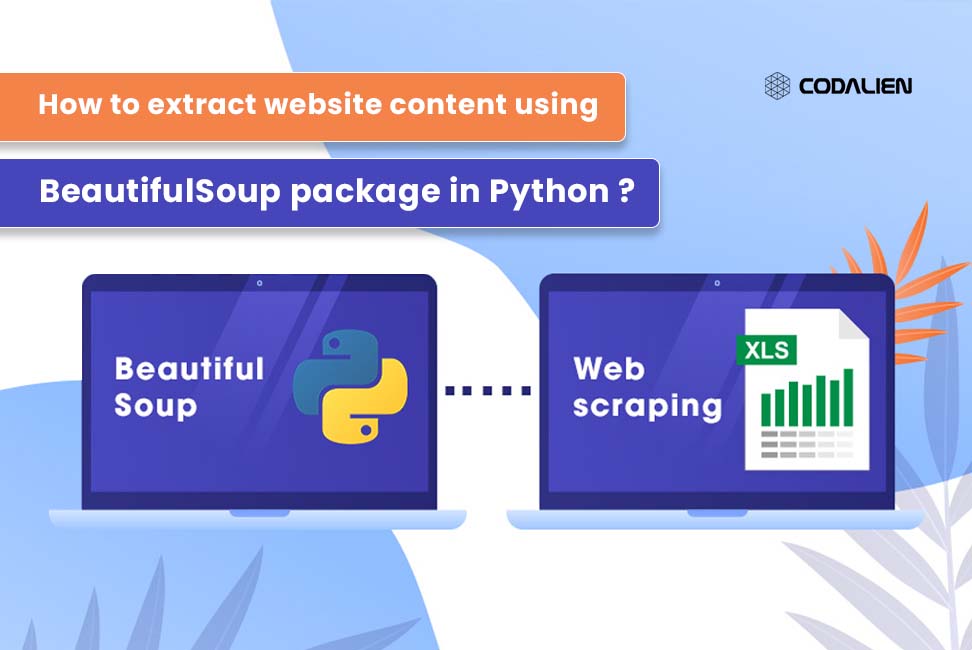There is a wealth of information available on the internet, and there may be occasions when you need to extract information from websites for things like web scraping, data analysis, or content aggregation. You can parse and extract data from HTML and XML documents using the BeautifulSoup Python library. In this lesson, we’ll look at how to do web scraping using Python BeautifulSoup.
Prerequisites
Now, let’s look at some setup tools. Make sure Python is installed on your machine before we start web scraping using BeautifulSoup. If not, you can get it from the official Python website and install it.
Installing the BeautifulSoup library is also required. Using pip, the Python package manager, you may accomplish this:
pip install beautifulsoup4
If you don’t have pip already installed then you can install it by this command:
python install pip
Getting Started with BeautifulSoup
We’ll scrape a sample webpage to demonstrate how BeautifulSoup may be used to extract website content. Importing the required libraries and retrieving the webpage’s content should come first. First we’ll use request package to make and http get request to the url to get the website’s html content.
import requests
from bs4 import BeautifulSoup
# Specify the URL of the webpage to scrape
url = 'https://example.com'
# Send an HTTP GET request to the URL
response = requests.get(url)
# Parse the HTML content of the page
soup = BeautifulSoup(response.text, 'html.parser')Code language: PHP (php)Exploring the HTML Structure
Now once we have the html content, we can extract the required tags or structures using different methods of the BeautifulSoup. For example, if you want to extract all the ‘p’ tags from the website you can use ‘soup.find_all(‘p’)’, this will extract all the ‘p’ tags along with other information such as its ‘class’, ‘id’, content, etc. suppose If you want to get only the first matching tag then you can use ‘find’ method. This will give you the first matching tag only and not all the tags of the website.
Extracting Data
Once you’ve identified the HTML elements that contain the data you want, you can use BeautifulSoup to extract that data. In this example, we’ll extract all the text within the <p> tags on the webpage:
# Find all <p> tags on the page
paragraphs = soup.find_all('p')
# Extract and print the text within the <p> tags
for p in paragraphs:
print(p.text)Code language: PHP (php)Here, first, we got all the ‘p’ tags with the help of the ‘find_all’ method and then we looped through all the ‘p’ elements and used the ‘text’ method to get the content inside each ‘p’ tag and print it.
Handling Errors
When scraping websites, errors must be managed. You might experience issues like missing components, network issues, or anti-scraping safeguards. Use status code checks and try-except blocks to properly manage errors:
try:
response = requests.get(url)
response.raise_for_status()
soup = BeautifulSoup(response.text, 'html.parser')
except requests.exceptions.RequestException as e:
print(f"Error: {e}")Code language: PHP (php)Conclusion
Web scraping is a useful ability for extracting data from websites for a variety of uses, but it must always be carried out responsibly and in accordance with the terms of service of the website in question. Thanks to its user-friendly API, Python web scraping with BeautifulSoup is a wonderful option.
Consider ethical issues, adhere to website policies, and respect robots.txt files because web scraping might strain web servers.
A robots.txt file is a text file used on websites to communicate with web crawlers or spiders, which are automated programs that search engines and other services use to browse the web and index its content. The primary purpose of the robots.txt file is to instruct these web crawlers on which parts of a website they are allowed to access and which parts they should avoid.
Example of ‘robots.txt’ file:
In this example, the asterisk (*) in User-agent means that the rules apply to all web crawlers. It instructs all crawlers not to access URLs under the /private/ and /admin/ directories.
The fundamentals of extracting webpage material using BeautifulSoup have been covered in this lesson. With this information, you may now scrape data from your preferred websites and use it for your particular applications.

